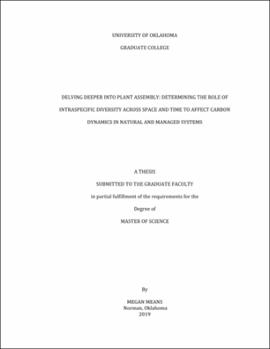| dc.contributor.advisor | Souza, Lara | |
| dc.contributor.author | Means, Megan | |
| dc.date.accessioned | 2019-05-10T14:05:39Z | |
| dc.date.available | 2019-05-10T14:05:39Z | |
| dc.date.issued | 2019-05-11 | |
| dc.identifier.uri | https://hdl.handle.net/11244/319678 | |
| dc.description.abstract | Understanding the key ecological processes contributing towards the spatial-temporal variation in intra-specific diversity of commonly occurring species, especially during early colonization events, can be key to predict how temperate prairies will be assembled and will function in the future. Specifically, little is known about the role of plant-plant interactions during population assembly following disturbance events to shape intra-specific variation/diversity and overall plant productivity. Priority effects state that individuals that arrive first will have advantages over late arriving, such as first access to nutrient and space for growth, which affect the later assembly of subsequent other individuals. This experiment will test whether priority effects play a role determining genotypic and phenotypic intra-specific variation and diversity in five plant species commonly occurring in the Southern Great Plains. To test the effects of priority effects modulating intra-specific variation and diversity across space and time, I collected plant species across nine sites along climatic gradient. Then I tested how phenotypic distance influence plant-plant interactions during early colonization to determine intra-specific variation and diversity. The results will help determine the role of plant-plant interactions during colonization to influence population assembly as it does community assembly playing a key role determining intra-specific diversity. These research results will strengthen our understanding of how diversity within species comes about and influences the rest of the community to shape ecosystem biodiversity and function, and may help us better manage the prairie habitat. Assembly is an important component of agriculture. In modern agriculture, crops are replanted every year. To do this a field is cleared or disturbed to become ready for the crop. The crop then assembles. The disturbance and crop assembly shape the new ecosystem and change it in drastic ways especially with nutrients in the soil. This study aims to understand how different treatments (annual, perennial, and restored prairie) will affect the soil carbon, nitrogen, and organic matter. Soil was collected at 0-15cm and 15-30cm for each treatment. Soil was then incubated for 120 days to determine the CO2 evolution and cumulative CO2. Soil was tested externally for nitrogen and soil organic matter. These results can help us better understand the effect of assembly on soil and offer a way to better manage agricultural soils through crop type. | en_US |
| dc.language | en_US | en_US |
| dc.subject | Carbon and nitrogen | en_US |
| dc.subject | Assembly and priority effects | en_US |
| dc.subject | Native and exotic grassland species | en_US |
| dc.subject | annual versus perennial agriculture systems | en_US |
| dc.title | Delving deeper into plant assembly: determine the role of intraspecific diversity across space and time to affect carbon dynamics in natural and managed systems | en_US |
| dc.contributor.committeeMember | Moore, Abigail | |
| dc.contributor.committeeMember | Hoagland, Bruce | |
| dc.date.manuscript | 2019-05-06 | |
| dc.thesis.degree | Master of Science | en_US |
| ou.group | College of Arts and Sciences::Department of Microbiology and Plant Biology | en_US |
| shareok.nativefileaccess | restricted | en_US |
